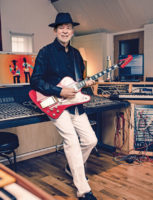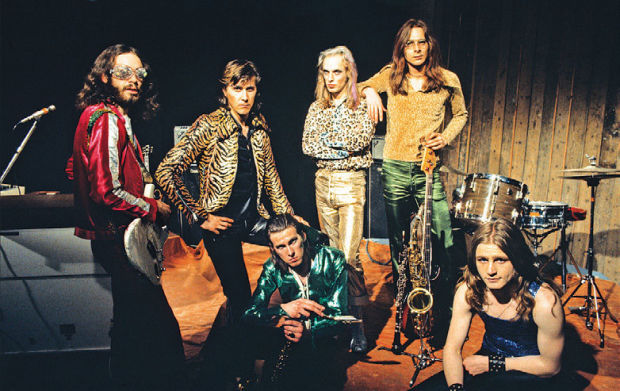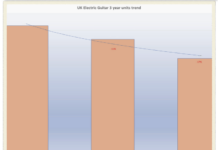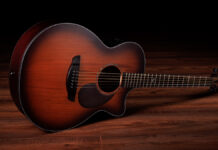
Phil Manzanera Talks Roxy Music History, Gibson Firebirds and His Neighbor and Occasional Bandmate, David Gilmour
He helped invent art rock as a member of Roxy Music, played with everyone from Brian Eno to David Gilmour to Bob Dylan and was sampled by Jay Z and Kanye West. But what Guitar World readers really want to know is…
Here on the 45th anniversary of the first Roxy music album, how does the record sound to you today? has it stood the test of time? —Kevin Warren
I don’t listen to it often, but I had to listen to it for this deluxe anniversary reissue project, and I was so pleased, really. And amazed that we had the bravery to actually do such a crazy album at that time. I find it difficult to categorize, stylewise. It’s not prog rock, it’s not glam… I answered an ad in the Melody Maker to join Roxy Music, and the ad said, “The perfect guitarist for avant rock group.” And there was a list of things they wanted: “original, creative, adaptable, melodic, fast, slow, elegant, witty, scary, stable, tricky. Quality musicians only.”
I was just desperate to join a band. I don’t really think I took that all in. But, looking back on it 45 years later, that surely sums up the style of Roxy Music—avant rock group. And all the little things they wanted, to me, sums up the band at that time. It was such a mixture. We all contributed bits and pieces. The one thing that stands out the most for me with Roxy Music was just a lot of humor. We were laughing constantly. Especially doing the weird stuff we were playing, we thought, If we look too serious, people are just going to get bored with this.
When and how did you first acquire the red 1964 Gibson Firebird that became your signature ax? —Gerry Ravinski
When I first joined Roxy Music, I had a Gibson 335—a beautiful thing. They took one look at it and said, “Oooh. No, no, no. You’ve got to have a white Strat.” So I got a white Strat and I used that and the 335 on the first album. But then, after being with them for a few months, the 335 got stolen.
And, again, in the back of the Melody Maker, I saw an ad for a red Gibson guitar. I had no idea what a Firebird was. But, growing up in South America, I’d had a Hofner Galaxie guitar, which was red. So I went along to this rich guy’s house in Regent’s Park in London. He opened the door and he was about 17 with this red Firebird. His parents were American. They’d come over from Kalamazoo and were living in this posh house. I took one look at the guitar and said, “I’ll take it.” I paid £150 and walked off with it. It’s been my signature guitar ever since. It was featured on the second Roxy Music album cover [For Your Pleasure, 1973]. It’s been a dream—and very effects-friendly.
Where did you get the idea to process your guitar through Brian Eno’s synthesizer during Roxy’s early days? —Todd Barnes
When I arrived on the scene, Eno was already treating Bryan Ferry’s piano and Andy McKay’s oboe with his [EML] VCS3 synthesizer, which was actually originally Andy’s. Basically, they were using the oboe and piano as sound sources for the VCS3, which is monophonic and just basically a series of oscillators, filters, a ring modulator and such.
And since a guitar can create feedback and other wild sounds, we said, “Right, let’s try the guitar.” To make the signal last longer, I would stick it through a Revox tape recorder, to get echoes and things, and then send it to Eno and then out to the P.A. It was very innovative. There was no one else doing that. It wasn’t until a few years later that Robert Fripp started doing something similar with Eno, which became Frippertronics.
Did you and Brian Eno mesh right away? He was proudly a “non musician” and you had just come from Quiet Sun, where you’d been playing in crazy, prog-rock time signatures. —Mark Mankovitz
We got along really well. I’d always loved the Velvet Underground, which was very much about few chords and soundscapes, really, through guitar feedback and things like that. So it wasn’t through any technical ability that we bonded. It was through repetitive stuff through using echo units and similar gear. And that came from systems music—composers like Terry Riley and Steve Reich—which we both loved. I used to bump into Eno at various avant garde concerts. So we got on really well. We even shared an apartment together for a while.
I read that you’ve known David Gilmour since the Seventies. So why did it take so long for the two of you to start making music together? —Gina Rockwell
I actually met David when I was 16, around 1967, when I came back full time to the U.K. from South America. I wanted to be a professional musician. I said to my mother, “I don’t want to go to university.” And she said, “My God, what are we going to do?” And my brother said, “I know this guy who has just become a professional musician.” And it was David Gilmour. My brother had been up at Cambridge University, and he said, “Let’s go and talk to him. Have lunch and ask him what you have do to become a professional musician?” So we went and had the lunch, and he can’t remember what he said. He later told me, “I must have said something fantastic, because five years later you managed to get yourself into Roxy Music.” After lunch, I remember we popped into his apartment opposite and he played guitar and then he went off to Abbey Road. He was recording on the first Pink Floyd album he was on [Saucerful of Secrets, 1968].
Then in 1987, I co-wrote the title track for A Momentary Lapse of Reason with him. I had the same manager, Steve O’Rourke, and Dave was nearby. I’d always kept in touch but never worked with him until then. But when I moved in 2001 to the country, I ended up living next door to him. I had no idea when we bought the house. It was just fate. Then, in 2005, he asked me to produce his solo album, On An Island. And 10 years later I worked with him on his next one, Rattle That Lock. We have a lot in common. Going back through the years, we find we have a lot of the same equipment, like, “Ah, you’ve got one of those too.” He gave me a nice little Gibson amp on my 60th birthday. It helps having a neighbor being David Gilmour.
What was it like doing the Guitar Legends festival in Seville in 1991 with all those legendary names like Bob Dylan, Keith Richards, Joe Satriani and Steve Cropper? —Art Ruggiero
That was one of the most amazing things in my life, although I was also worried, to a certain extent. I was the music director and I had to organize the whole night. The guy who was producing it said, “Would you be the musical director for it? We’ve got a budget of seven million dollars. It’s going to go out live in America and in the U.K. on BBC. Five nights.” There was a different concept for each night—a jazz night, a blues night, a country night, whatever. And one night had no concept, and I said, “Yeah, that’s going to be my night.” And he said, “Okay, your night is going to be Bob Dylan, Keith Richards, Joe Cocker…” I said, “Joe Cocker’s not a guitarist.” “Well, he plays air guitar. We need the big names for the TV people. But you’re going to have to rehearse Bob Dylan for a week, underneath the stage… with this amazing band.”
The manager came in and said, “This is Bob. Bob, this is Phil.” And then we began negotiating with him what tracks we were going to play, which, of course, we didn’t end up playing. But I just kept thinking, Wow, this is Bob Dylan. I’ll just do whatever he wants, ’cause he’s a genius.
If you look at the footage on YouTube, you can see we’re all looking around. The manager said, “He might come on. He might not. And if he doesn’t, who’s gonna sing the songs?” And Jack Bruce, who was in the band, says, “Don’t look at me.” The manager says, “Well, if you do see him coming on, make sure you introduce him.” So I looked ’round to see his spotted shirt coming out of the blackness. “Senors y senores, Bob Dylan!” And we proceeded to not play any of the stuff we’d rehearsed. You can see us all looking at each other saying, “Is that a C chord?” “What key are we in?”

How did your background in Latin American music influence your work with Roxy music and as a solo artist? —Virginia Ramos
I have a Columbian mother. I grew up in Cuba, Venezuela and Columbia. My mother started teaching me guitar when I was seven, in Havana, before the revolution. What I got from her was the groove—the rhythms she loved, which was cumbia and stuff like that. That influenced me to always try, through the use of echo, to play double-time in Roxy Music. I would say, “Come on guys, let’s groove it up a bit.” It was not easy, because there wasn’t a lot of space.
But over my whole period of playing with Roxy, there were various times where I managed to get it in, just by using eighth and or sixteenth notes with an echo repeat. But apart from that, nothing really. Throughout the entire Seventies, nobody was interested in my background from South America. But in my solo work, I started referencing some of those things.
Source: www.guitarworld.com












